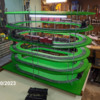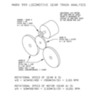Hi Mike! I ran postwar and MPC for years (and made a good-faith attempt to run them at realistic speeds, imagine that!!) I also observed that they tended to speed up as the motors got warm. I never figured out why, nor was I able to tame that tendency. Some people attributed it to friction or lubrication, but I don't think that explains everything. I believe the internal resistance of the motor or its magnetic flux changes with temperature, and the motors seem to run faster with less torque. For your consideration, I recently posted this little-known fact on another thread:
"The speed of the toy motor can be reduced by bridging a 4-ohm resistor across the brushes of the motor but not across the field. This resistor acts as a shunt to by-pass some of the current around the armature thus causing the armature to get less current and the field more current. In this way a definite speed reduction can be obtained. However, this scheme will not work with all motors equally well and some experimentation may be necessary to determine the exact value of the resistor. It should not be less than 4 ohms and should not be more than 10." --W. K. Walthers, Handbook for Model Railroaders, Kalmbach Publishing Co., 1946.
If you took your fastest runner and added a resistor as described above, I wonder if it would tame the speed variation? You would have to put more voltage into the track, for sure. Some kind of variable resistor would be amazing, because then you could adjust it as the loco warmed up.
You could also put a full-wave bridge rectifier between the transformer and track, and try running your trains on DC. They will probably run quieter and more consistently. This is a fine way to run "traditional" trains, as long as you don't have horns or whistles built into the locomotive because in that case they will sound continuously!
I like the way double-reduction Marx motors run. I think the extra gearing translates to a smaller percent change in RPM for a given a change in voltage or resistance. That means more consistent running. I would bet that a double-reduction Marx will outperform the Lionel double-reduction 2-4-2, especially if the Marx is a non-smoker (it won't have to contend with the momentary drag of the smoke puffer.) It'll be fun to find out!
Also... With series-wound motors as used by Lionel and Marx, speed is inherently sensitive to load. Your layout looks great and I'm sure you've made every effort to keep things level. But any kind of sag or downhill will cause the train to speed up.
Last thing AND THIS IS IMPORTANT... I know the ZW is cool with four throttles and all. But... it's NOT the best choice for precise control. If one loco starts working harder for any reason, it draws more current which subtlely reduces the voltage to the other 3 mainlines. If you really want consistent control, power each loop with its own small transformer. Trust me on this!
Look forward to more of your videos, and further posts as you experiment and test the other locos!










